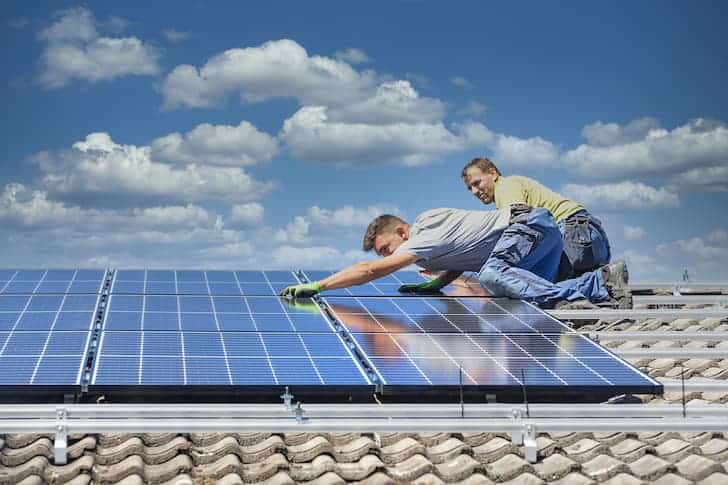A sizable new solar tax credit has arrived. By 2022, the Inflation Reduction Act will have increased the federal incentive for home solar installations by 30%. That’s fantastic news for both residential users and the solar energy market as a whole. These federal benefits have been guaranteed for the next decade, so the price of solar is expected to continue falling rapidly, making it more affordable for American homeowners.
According to Shawn Rumery, senior director of research for the Solar Energy Industries Association, “If anything, the IRA just helped supercharge an already-hot market.”


Here is what you may anticipate to pay for solar power over the next five to ten years, according to industry experts.
Expenses will decrease even further
The price of solar energy has been decreasing for many years.
“Over the last decade, prices have come down by more than 50% in the residential space,” Rumery added.
These days, a rooftop solar system will set you back roughly $25,000. Due to improvements in installation, including more efficient labor and permitting processes, the price has dropped from around $50,000 just ten years ago. “You’ve seen, generally, costs come down in the previous decade. “That’s been a huge factor in the growth of the solar industry,” Rumery added.
Though solar price drops have been transient owing to supply chain bottlenecks, he believes the trend will continue.
Growth in this business as a whole is a major factor that could lead to further its price declines.
Read More: M.O.B.A. Network Buys Wargraphs for $53.9M
Progress toward industrial maturity is inevitable
There will be a federal solar tax credit for the foreseeable future. That’s good news for everyone involved in the solar business, from installers to manufacturers, because it means they can move forward with plans to expand.
VP of Gabel Associates and energy consultant Pamela Frank praised the plan’s longevity, saying it sent a positive message to developers. Consumers will gain in general from that.
Rumery said that this would allow both installers and manufacturers to make large-scale, long-term investments in their businesses. Moreover, “the market certainty created by the [Inflation Reduction Act] really helps in that front,” he said.
The end result should be reduced prices for shoppers. The panels themselves will become cheaper and easier to export as a result of economies of scale and the possibility of new domestic solar manufacturing facilities, mitigating some of the international supply chain challenges now plaguing the industry.
There will still be challenges
The positive news about the federal increase for solar is mitigated somewhat by challenges at the state and international levels.
Inflationary pressures on a wide range of consumer goods have been compounded by problems in the global supply chain. Even solar isn’t exempt from that, and it’s leading to small price hikes in the residential sector. Rumery argued that “supply chains” needed to be strengthened.
The federal government has shown a lot of support for solar energy, but state rules are still all over the place. Rumery argued that “state policy has a significant impact on the market.”
Rumery predicts that the cost of solar energy will decrease even further in states that offer large incentives on top of federal subsidies. However, he warned that states without such regulations would have slower rates of affordability and acceptance.
Read More: Porsche Mission X: Dreaming Again
Growth in energy storage is inevitable
The cost of the panels is quite high. The addition of a battery, which is essential for optimal performance, is yet another must-have accessory.
Frank emphasized that solar plus storage was the most innovative concept for consumers.
More and more homeowners are choosing to complement their solar panels with a large battery. Because of the increasing frequency and severity of storms and subsequent power outages, it is important to have a reliable backup power supply.
The cost of storage is high, but there are tax breaks available, as Frank pointed out. A home battery installation is eligible for the 30% federal tax credit that is currently offered for panels.
As more individuals invest in panels, the demand for household batteries will rise and eventually bring prices down. We’re seeing that couple because, to put it bluntly, it makes sense, as Frank put it.
Those around you will band together to help you
A solar system will still cost you more than a few thousand dollars, despite all the hoopla about how affordable they are, but there are methods to cut costs.
Cooperating with neighbors is an effective strategy for lowering solar energy costs. You may be able to get a bulk discount from an installation if you and three or five of your neighbors all decide to go solar.
Keep a look out for solar-equipped neighbors, since they may prove to be invaluable resources. After going solar, “people become sort of evangelical about it,” Frank added. They could provide information or recommend a reliable solar installer based on your inquiry.
You and your neighbors may qualify for additional federal solar rebates. Rumery stated that the Inflation Reduction Act includes additional incentives for poor and moderate-income households, as well as those residing in neighborhoods near fossil fuel facilities or other polluting sectors, while the specifics are still being ironed out.
“The sector is making serious efforts to penetrate middle- and lower-income neighborhoods. And I believe it is something we must maintain,” Rumery remarked.
Whether you own your home or rent, you always have the option of joining a community solar project. Without putting the panels on your roof, you can sign up for power from a nearby solar farm.
Read More: Musk Wants Twitter to Replace CNN
The use of solar energy will skyrocket
Many people still see rooftop solar as a fresh concept. In spite of this, solar contributes barely 5% of US energy output.
However, Rumery predicts that this will alter in the not-too-distant future. By 2030, his group estimates, solar energy will account for around 20% of the United States’ total energy production. Consumers might save even more money as a result, and rooftop solar could become as common as a dishwasher, according to Rumery.
I don’t think ‘Can you afford to go solar?’ is going to be an issue in five or ten years. Can you afford not to go solar? will be the new catchphrase. It was Rumi’s words.
While it’s possible that solar energy prices will continue to drop, according to Frank, it’s not worth holding off on a purchase until then.
The timing is right now, she said.
FAQs
The cost of solar panels varies depending on the size of the system, the type of panels, and the installation costs in your area. In general, the cost of solar panels has been decreasing in recent years, and they are now more affordable than ever before.
Solar panels are very durable and can last for 25 to 35 years. The various components of your solar power system will need to be replaced at different times, but your system should continue to generate electricity for many years to come.




